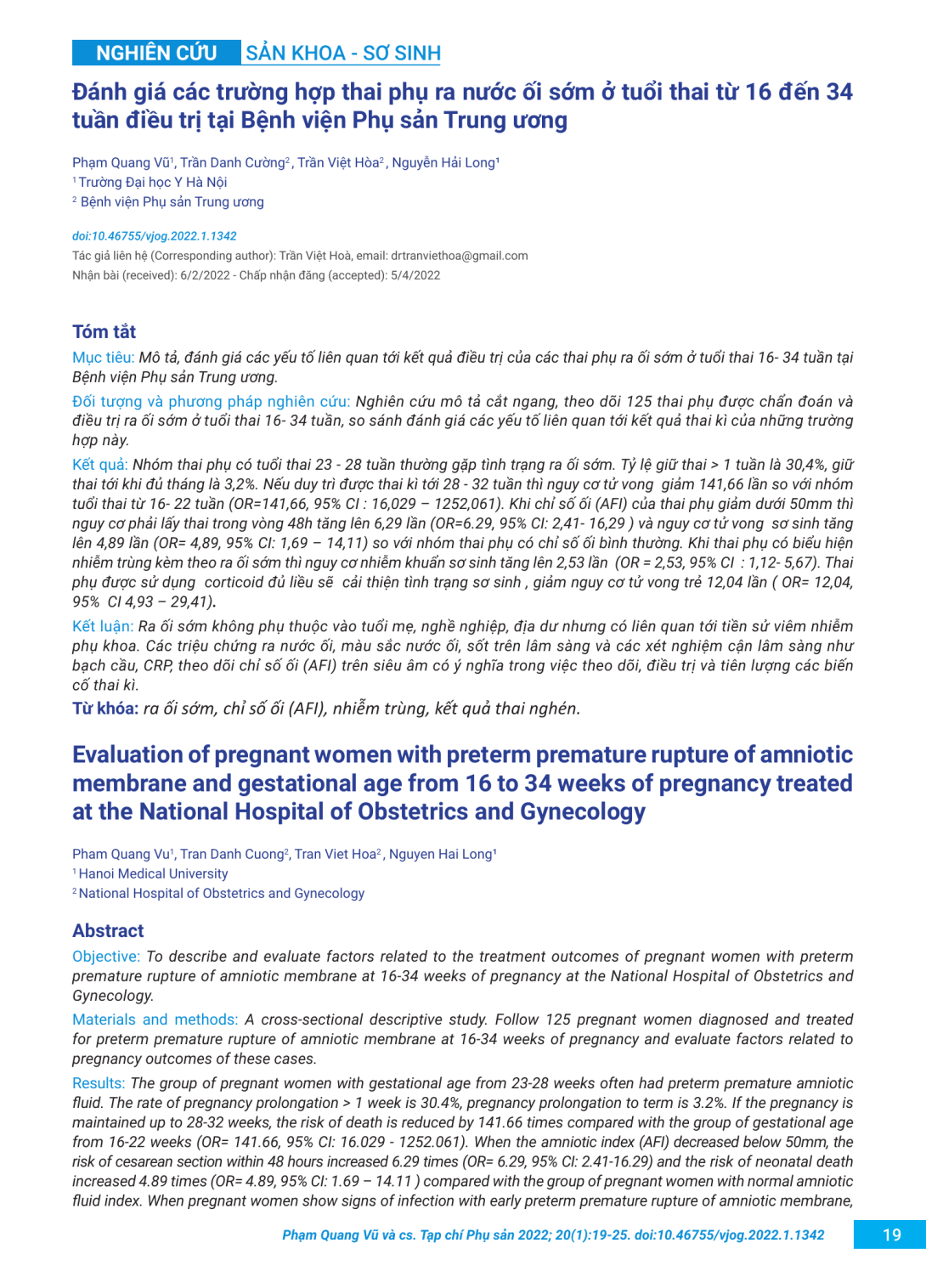
Mô tả, đánh giá các yếu tố liên quan tới kết quả điều trị của các thai phụ ra ối sớm ở tuổi thai 16- 34 tuần tại Bệnh viện Phụ sản Trung ương. Đối tượng và phương pháp nghiên cứu: Nghiên cứu mô tả cắt ngang, theo dõi 125 thai phụ được chẩn đoán và điều trị ra ối sớm ở tuổi thai 16- 34 tuần, so sánh đánh giá các yếu tố liên quan tới kết quả thai kì của những trường hợp này. Kết quả: Nhóm thai phụ có tuổi thai 23 - 28 tuần thường gặp tình trạng ra ối sớm. Tỷ lệ giữ thai > 1 tuần là 30,4%, giữ thai tới khi đủ tháng là 3,2%. Nếu duy trì được thai kì tới 28 - 32 tuần thì nguy cơ tử vong giảm 141,66 lần so với nhóm tuổi thai từ 16- 22 tuần (OR=141,66, 95% CI : 16,029 – 1252,061). Khi chỉ số ối (AFI) của thai phụ giảm dưới 50mm thì nguy cơ phải lấy thai trong vòng 48h tăng lên 6,29 lần (OR=6.29, 95% CI: 2,41- 16,29 ) và nguy cơ tử vong sơ sinh tăng lên 4,89 lần (OR= 4,89, 95% CI: 1,69 – 14,11) so với nhóm thai phụ có chỉ số ối bình thường. Khi thai phụ có biểu hiện nhiễm trùng kèm theo ra ối sớm thì nguy cơ nhiễm khuẩn sơ sinh tăng lên 2,53 lần (OR = 2,53, 95% CI : 1,12- 5,67). Thai phụ được sử dụng corticoid đủ liều sẽ cải thiện tình trạng sơ sinh , giảm nguy cơ tử vong trẻ 12,04 lần ( OR= 12,04, 95% CI 4,93 – 29,41). Kết luận: Ra ối sớm không phụ thuộc vào tuổi mẹ, nghề nghiệp, địa dư nhưng có liên quan tới tiền sử viêm nhiễm phụ khoa. Các triệu chứng ra nước ối, màu sắc nước ối, sốt trên lâm sàng và các xét nghiệm cận lâm sàng như bạch cầu, CRP, theo dõi chỉ số ối (AFI) trên siêu âm có ý nghĩa trong việc theo dõi, điều trị và tiên lượng các biến cố thai kì.
To describe and evaluate factors related to the treatment outcomes of pregnant women with preterm premature rupture of amniotic membrane at 16-34 weeks of pregnancy at the National Hospital of Obstetrics and Gynecology. Materials and methods: A cross-sectional descriptive study. Follow 125 pregnant women diagnosed and treated for preterm premature rupture of amniotic membrane at 16-34 weeks of pregnancy and evaluate factors related to pregnancy outcomes of these cases. Results: The group of pregnant women with gestational age from 23-28 weeks often had preterm premature amniotic fluid. The rate of pregnancy prolongation > 1 week is 30.4%, pregnancy prolongation to term is 3.2%. If the pregnancy is maintained up to 28-32 weeks, the risk of death is reduced by 141.66 times compared with the group of gestational age from 16-22 weeks (OR= 141.66, 95% CI: 16.029 - 1252.061). When the amniotic index (AFI) decreased below 50mm, the risk of cesarean section within 48 hours increased 6.29 times (OR= 6.29, 95% CI: 2.41-16.29) and the risk of neonatal death increased 4.89 times (OR= 4.89, 95% CI: 1.69 – 14.11 ) compared with the group of pregnant women with normal amniotic fluid index. When pregnant women show signs of infection with early preterm premature rupture of amniotic membrane the risk of neonatal sepsis increases 2.53 times (OR = 2.53, 95% CI: 1.12-5.67). Pregnant women who use corticosteroid therapy will improve their neonatal status, reduce the risk of infant mortality 12.04 times (OR= 12.04, 95% CI 4.93 – 29.41). Conclusion: Preterm premature rupture of amniotic membrane is not dependent on maternal age, occupation, or geography, but is associated with a history of gynecological infections. The clinical symptoms such as leak of amniotic fluid, amniotic fluid color, fever and paraclinical tests such as white blood cell count, CRP, amniotic index (AFI) monitoring on ultrasound are meaningful in monitoring, treatment and prognosis of pregnancy outcomes.
- Đăng nhập để gửi ý kiến
